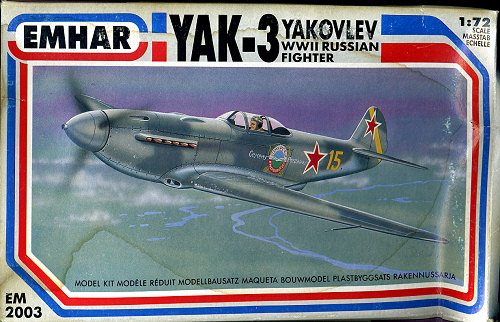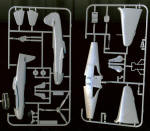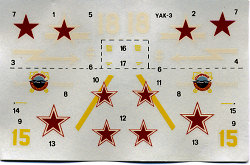
| KIT: | Emhar 1/72 Yak-3 |
| KIT #: | EM 2003 |
| PRICE: | Got mine for $2 in a very soggy condition |
| DECALS: | Two options |
| REVIEWER: | Scott Van Aken |
| NOTES: | Ex-Frog Mold |

| HISTORY |
In 1943, Yakovlev designed Yak-1M which was a smaller and lighter version of Yak-1. A second Yak-1M prototype was constructed later that year, differing from the first aircraft in plywood instead of fabric covering of the rear fuselage, mastless radio antenna, reflector gunsight, and improved armor and engine cooling. The chief test pilot for the project Piotr Mikhailovich Stefanovskiy was so impressed with the new aircraft that he recommended that it should completely replace Yak-1 and Yak-7 with only Yak-9 retained in production for further work with the Klimov VK-107 engine. The new fighter, designated Yak-3 entered service in 1944, later than Yak-9 in spite of the lower designation number. A total of 4,848 aircraft were produced.
Lighter and smaller than Yak-9 but powered by the same engine, Yak-3 was a very agile dogfighter and a forgiving, easy to handle aircraft loved by both rookie and veteran pilots. Early combat experience found it to be superior to all Luftwaffe fighters at altitudes below 5,000 m (16,400 ft). It could roll with the Focke-Wulf Fw 190 and its turn was far superior; a full circle in 18.6 seconds. The two biggest drawbacks of the aircraft were its short range and the tendency of the glued-on plywood covering the top of the wings to tear away under high-G loads. The pneumatic system for actuating landing gear, flaps, and brakes, typical for all Yakovlev fighters of the time was also less reliable than the hydraulic or electrical systems, but it was preferred due to significant weight savings. The first 197 Yak-3 were armed with a single 20 mm ShVAK cannon and one 12.7 mm UBS machine gun, with subsequent aircraft receiving a second UBS for a weight of fire of 2.72 kg (6.0 lb) per second using high-explosive ammunition.
The designation Yak-3 was also used for three other Yakovlev projects - a Yakovlev Yak-1 modification with all-metal wings and increased armament known as I-30, a proposed but never built heavy twin-engine fighter, and Yakovlev Yak-7A.
Since 1991, a number of Yak-3 have been newly manufactured by Yakovlev for the warbird market using the original plans and dies. These are powered by Allison V-1710 engines and have the designation Yak-3M. Several of these are airworthy today, mostly in the United States, but also in Germany and Australia. Others have been converted to "Yak-3" status from Yak-11 trainers (with the fitment of a Allison engine) for private owners, with these aircraft also being very popular worldwide.
| THE KIT |
 This
kit should look vaguely familiar in the way that it is molded. When Frog went
out of business in 1976, there were several projects that had reached the mold
stage, but had not yet been produced. This included the fabled Ventura (which
when a similar kit was released by Minicraft proved to be a bit of a flop) as
well as four Soviet fighters. One of these was the Yak-3 and along with its
brethren was initially packaged as a group and later individually by Red Star.
Eventually the Yak-3 entered into the Emhar family, still carrying F311 stamped
on its sprues.
This
kit should look vaguely familiar in the way that it is molded. When Frog went
out of business in 1976, there were several projects that had reached the mold
stage, but had not yet been produced. This included the fabled Ventura (which
when a similar kit was released by Minicraft proved to be a bit of a flop) as
well as four Soviet fighters. One of these was the Yak-3 and along with its
brethren was initially packaged as a group and later individually by Red Star.
Eventually the Yak-3 entered into the Emhar family, still carrying F311 stamped
on its sprues.
In common with other Frog kits, this one is not at all
complex. It has fine raised panel line detailing, a set of optional 'gear up'
landing gear doors, large attachment points, a minimal cockpit and a rather
thick, but clear canopy. Typical of most Emhar kits I've seen, this one has some
sink areas to be filled and some curious thick 'squiggles' on the surface
plastic of many of the large parts. Not sure if that will be visible under a
coat of paint, but I'd think not. Once the sink areas have been filled and sanded down, construction should move rather quickly.
filled and sanded down, construction should move rather quickly.
The instructions are a single, small sheet of paper with 6 construction steps on one side and a color diagram on the other. Two options are provided. One is the box top aircraft in grey/green-grey over light blue. The other is a Normadie-Niemen aircraft in green uppers and light blue undersides. Frankly, I doubt this latter scheme and the plane was probably in the standard Soviet colors of the first aircraft. The decals look fairly well printed, but as mine are water-damaged they are not usable. They also seem a bit transparent as I can see the blue backing through the white parts.
| CONCLUSIONS |
This is a pleasant kit for a nice afternoon's work and is one that could easily be called a 'weekend special'. Those who want a more detailed Yak-3 kit will probably gravitate towards the Heller kit and perhaps there is even a newer one about which I do not know. Regardless, this is a kit that sells for today's equivalent of pocket change and can easily be found.
February 2007
Thanks to me and a small flood at CRM for this kit.
If you would like your product reviewed fairly and quickly by a site that has over 350,000 visits a month, please contact me or see other details in the Note to Contributors.